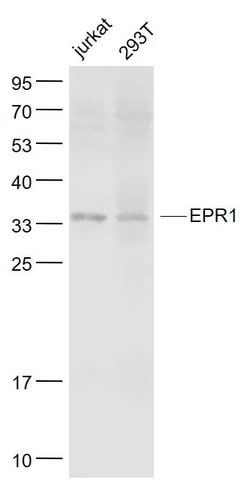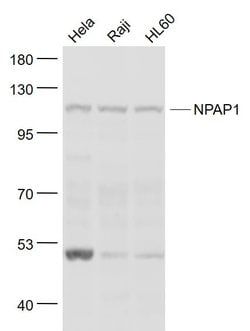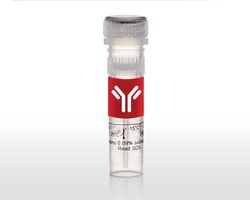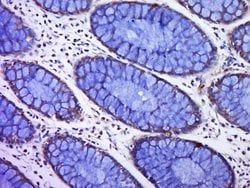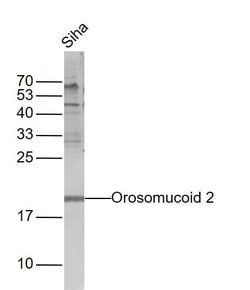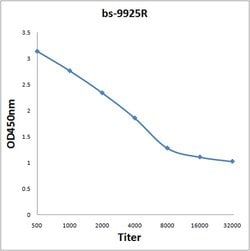50-198-9448
Orosomucoid 2 Rabbit anti-Human, Polyclonal, Bioss
Manufacturer: Bioss
Select a Size
| Pack Size | SKU | Availability | Price |
|---|---|---|---|
| Each of 1 | 50-198-9448-Each-of-1 | In Stock | ₹ 36,897.75 |
50-198-9448 - Each of 1
In Stock
Quantity
1
Base Price: ₹ 36,897.75
GST (18%): ₹ 6,641.595
Total Price: ₹ 43,539.345
Antigen
Orosomucoid 2
Classification
Polyclonal
Conjugate
Unconjugated
Gene
ORM2
Gene Alias
AGP 2; Agp1; AGP2; Agp-2; AGP-B; AGP-B′; alpha-1-acid glycoprotein 1; Alpha-1-acid glycoprotein 2; alpha-1-acid glycoprotein, type 2; bM340H1.5 (orosomucoid 2); OMD 2; OMD2; Orm2; Orm-2; orosomucoid 2; Orosomucoid2; Orosomucoid-2
Host Species
Rabbit
Purification Method
Protein A
Regulatory Status
RUO
Gene ID (Entrez)
5005
Content And Storage
-20°C
Form
Liquid
Applications
Immunofluorescence, Immunohistochemistry (Paraffin), Western Blot
Concentration
1 μg/mL
Formulation
PBS with 1% BSA, 50% glycerol and 0.09% sodium azide; pH
Gene Accession No.
P19652
Gene Symbols
ORM2
Immunogen
KLH conjugated synthetic peptide derived from human Orosomucoid 2.
Quantity
100 μL
Primary or Secondary
Primary
Target Species
Human
Product Type
Antibody
Isotype
IgG
Description
- AGP (a 1-acid Glycoprotein) is an acute phase plasma protein synthesized by the liver
- It functions to regulate the interaction between blood cells and endothelial cells, and together with haptoglobin and C reactive protein, it also mediates the extravasation of cells during infection and inflammation
- Expression of AGP is induced by acute-phase stimulatory agents such as bacterial lipopolysaccharides
- AGP has a high affinity, low capacity binding for basic drugs at physiological pH
- In human plasma, AGP is found at levels of 0.5-1.4 mg/ml, though this is elevated during acute inflammation, and, as a result, levels of this protein can be used to diagnose inflammatory conditions
- Multiple AGP genes exist, including AGP-1, AGP-2, AGP-3 and AGP-8
- AGP-1 and AGP-2 contain five and six potential N-glycosylation sites, respectively
- Abnormal expression of the APG-1 gene is linked to sarcoidosis and other immunogenetic diseases, while mutations in the APG-2 gene are associated with different types of carcinomas.
Compare Similar Items
Show Difference
Antigen: Orosomucoid 2
Classification: Polyclonal
Conjugate: Unconjugated
Gene: ORM2
Gene Alias: AGP 2; Agp1; AGP2; Agp-2; AGP-B; AGP-B′; alpha-1-acid glycoprotein 1; Alpha-1-acid glycoprotein 2; alpha-1-acid glycoprotein, type 2; bM340H1.5 (orosomucoid 2); OMD 2; OMD2; Orm2; Orm-2; orosomucoid 2; Orosomucoid2; Orosomucoid-2
Host Species: Rabbit
Purification Method: Protein A
Regulatory Status: RUO
Gene ID (Entrez): 5005
Content And Storage: -20°C
Form: Liquid
Applications: Immunofluorescence, Immunohistochemistry (Paraffin), Western Blot
Concentration: 1 μg/mL
Formulation: PBS with 1% BSA, 50% glycerol and 0.09% sodium azide; pH
Gene Accession No.: P19652
Gene Symbols: ORM2
Immunogen: KLH conjugated synthetic peptide derived from human Orosomucoid 2.
Quantity: 100 μL
Primary or Secondary: Primary
Target Species: Human
Product Type: Antibody
Isotype: IgG
Antigen:
Orosomucoid 2
Classification:
Polyclonal
Conjugate:
Unconjugated
Gene:
ORM2
Gene Alias:
AGP 2; Agp1; AGP2; Agp-2; AGP-B; AGP-B′; alpha-1-acid glycoprotein 1; Alpha-1-acid glycoprotein 2; alpha-1-acid glycoprotein, type 2; bM340H1.5 (orosomucoid 2); OMD 2; OMD2; Orm2; Orm-2; orosomucoid 2; Orosomucoid2; Orosomucoid-2
Host Species:
Rabbit
Purification Method:
Protein A
Regulatory Status:
RUO
Gene ID (Entrez):
5005
Content And Storage:
-20°C
Form:
Liquid
Applications:
Immunofluorescence, Immunohistochemistry (Paraffin), Western Blot
Concentration:
1 μg/mL
Formulation:
PBS with 1% BSA, 50% glycerol and 0.09% sodium azide; pH
Gene Accession No.:
P19652
Gene Symbols:
ORM2
Immunogen:
KLH conjugated synthetic peptide derived from human Orosomucoid 2.
Quantity:
100 μL
Primary or Secondary:
Primary
Target Species:
Human
Product Type:
Antibody
Isotype:
IgG
Antigen: PAPP A2
Classification: Polyclonal
Conjugate: Unconjugated
Gene: PAPPA2
Gene Alias: LOC680415; PAPPA2; PAPP-A2; pappalysin 2; Pappalysin-2; Pappe; PAPP-E; PLAC3; placenta-specific 3; pregnancy-associated plasma preproprotein-A2; Pregnancy-associated plasma protein A2; Pregnancy-associated plasma protein E1; pregnancy-associated plasma protein-E; RP4-774I24.1; similar to pappalysin 2 isoform 1
Host Species: Rabbit
Purification Method: Protein A
Regulatory Status: RUO
Gene ID (Entrez): 60676
Content And Storage: -20°C
Form: Liquid
Applications: Immunofluorescence, Immunohistochemistry (Paraffin), Western Blot
Concentration: 1 μg/mL
Formulation: PBS with 1% BSA, 50% glycerol and 0.09% sodium azide; pH
Gene Accession No.: Q9BXP8
Gene Symbols: PAPPA2
Immunogen: KLH conjugated synthetic peptide derived from human PAPP A2.
Quantity: 100 μL
Primary or Secondary: Primary
Target Species: Human
Product Type: Antibody
Isotype: IgG
Antigen:
PAPP A2
Classification:
Polyclonal
Conjugate:
Unconjugated
Gene:
PAPPA2
Gene Alias:
LOC680415; PAPPA2; PAPP-A2; pappalysin 2; Pappalysin-2; Pappe; PAPP-E; PLAC3; placenta-specific 3; pregnancy-associated plasma preproprotein-A2; Pregnancy-associated plasma protein A2; Pregnancy-associated plasma protein E1; pregnancy-associated plasma protein-E; RP4-774I24.1; similar to pappalysin 2 isoform 1
Host Species:
Rabbit
Purification Method:
Protein A
Regulatory Status:
RUO
Gene ID (Entrez):
60676
Content And Storage:
-20°C
Form:
Liquid
Applications:
Immunofluorescence, Immunohistochemistry (Paraffin), Western Blot
Concentration:
1 μg/mL
Formulation:
PBS with 1% BSA, 50% glycerol and 0.09% sodium azide; pH
Gene Accession No.:
Q9BXP8
Gene Symbols:
PAPPA2
Immunogen:
KLH conjugated synthetic peptide derived from human PAPP A2.
Quantity:
100 μL
Primary or Secondary:
Primary
Target Species:
Human
Product Type:
Antibody
Isotype:
IgG
Antigen: CAMK2D
Classification: Polyclonal
Conjugate: Unconjugated
Gene: Camk2d
Gene Alias: [d]-CaMKII; 2810011D23Rik; 8030469K03Rik; Ca++/calmodulin-dependent protein kinase 2 delta subunit; Ca++/calmodulin-dependent protein kinase II delta subunit; Ca++/calmodulin-dependent protein kinase II, delta subunit; calcium/calmodulin dependent protein kinase II delta; calcium/calmodulin-dependent protein kinase (CaM kinase) II delta; calcium/calmodulin-dependent protein kinase II delta; calcium/calmodulin-dependent protein kinase II, delta; calcium/calmodulin-dependent protein kinase type II delta chain; Calcium/calmodulin-dependent protein kinase type II subunit delta; calmodulin-dependent protein kinase II-delta dash; CaM kinase II delta subunit; CaM kinase II subunit delta; CAM2; CaMK II; CAMK1; Camk2; CAMK2B; CAMK2D; CAMK2G; CAMKB; CAMKD; CAMKG; Camki; CaMK-II delta subunit; caMK-II subunit delta; caM-kinase II delta chain; Kiaa4163; LOC100101557; RATCAMKI
Host Species: Rabbit
Purification Method: Protein A
Regulatory Status: RUO
Gene ID (Entrez): 817
Content And Storage: -20°C
Form: Liquid
Applications: Immunofluorescence, Immunohistochemistry (Paraffin), Western Blot
Concentration: 1 μg/mL
Formulation: PBS with 1% BSA, 50% glycerol and 0.09% sodium azide; pH
Gene Accession No.: Q13557
Gene Symbols: Camk2d
Immunogen: KLH conjugated synthetic peptide derived from human CAMK2D/CaMKII delta.
Quantity: 100 μL
Primary or Secondary: Primary
Target Species: Human
Product Type: Antibody
Isotype: IgG
Antigen:
CAMK2D
Classification:
Polyclonal
Conjugate:
Unconjugated
Gene:
Camk2d
Gene Alias:
[d]-CaMKII; 2810011D23Rik; 8030469K03Rik; Ca++/calmodulin-dependent protein kinase 2 delta subunit; Ca++/calmodulin-dependent protein kinase II delta subunit; Ca++/calmodulin-dependent protein kinase II, delta subunit; calcium/calmodulin dependent protein kinase II delta; calcium/calmodulin-dependent protein kinase (CaM kinase) II delta; calcium/calmodulin-dependent protein kinase II delta; calcium/calmodulin-dependent protein kinase II, delta; calcium/calmodulin-dependent protein kinase type II delta chain; Calcium/calmodulin-dependent protein kinase type II subunit delta; calmodulin-dependent protein kinase II-delta dash; CaM kinase II delta subunit; CaM kinase II subunit delta; CAM2; CaMK II; CAMK1; Camk2; CAMK2B; CAMK2D; CAMK2G; CAMKB; CAMKD; CAMKG; Camki; CaMK-II delta subunit; caMK-II subunit delta; caM-kinase II delta chain; Kiaa4163; LOC100101557; RATCAMKI
Host Species:
Rabbit
Purification Method:
Protein A
Regulatory Status:
RUO
Gene ID (Entrez):
817
Content And Storage:
-20°C
Form:
Liquid
Applications:
Immunofluorescence, Immunohistochemistry (Paraffin), Western Blot
Concentration:
1 μg/mL
Formulation:
PBS with 1% BSA, 50% glycerol and 0.09% sodium azide; pH
Gene Accession No.:
Q13557
Gene Symbols:
Camk2d
Immunogen:
KLH conjugated synthetic peptide derived from human CAMK2D/CaMKII delta.
Quantity:
100 μL
Primary or Secondary:
Primary
Target Species:
Human
Product Type:
Antibody
Isotype:
IgG
Antigen: CACNA1S
Classification: Polyclonal
Conjugate: Unconjugated
Gene: CACNA1S
Gene Alias: AW493108; CACH1; Cacn1; Cacna1s; Cacnl1a3; calcium channel, L type, alpha 1 polypeptide, isoform 3 (skeletal muscle, hypokalemic periodic paralysis); Calcium channel, L type, alpha-1 polypeptide, isoform 3, skeletal muscle; calcium channel, voltage-dependent, L type, alpha 1S subunit; calcium voltage-gated channel subunit alpha1 S; Cav1.1; Cav1.1 alpha-1; Cchl1a3; DHP; DHPR; DHPR alpha1s; dihydropyridine receptor; dihydropyridine receptor alpha 1 subunit; dihydropyridine receptor alpha 1S; Dihydropyridine receptor alpha-1S subunit; dihydropyridine-sensitive L-type calcium channel alpha-1 subunit; fmd; HOKPP; HOKPP1; hypoPP; mdg; MHS5; muscle dysgenesis; ROB1; sj; TTPP1; Voltage-dependent L-type calcium channel subunit alpha-1S; Voltage-gated calcium channel subunit alpha Cav1.1
Host Species: Rabbit
Purification Method: Protein A
Regulatory Status: RUO
Gene ID (Entrez): 779
Content And Storage: -20°C
Form: Liquid
Applications: ELISA, Immunofluorescence, Immunohistochemistry (Paraffin)
Concentration: 1 μg/mL
Formulation: PBS with 1% BSA, 50% glycerol and 0.09% sodium azide; pH
Gene Accession No.: Q13698
Gene Symbols: CACNA1S
Immunogen: KLH conjugated synthetic peptide derived from human CACNA1S.
Quantity: 100 μL
Primary or Secondary: Primary
Target Species: Human
Product Type: Antibody
Isotype: IgG
Antigen:
CACNA1S
Classification:
Polyclonal
Conjugate:
Unconjugated
Gene:
CACNA1S
Gene Alias:
AW493108; CACH1; Cacn1; Cacna1s; Cacnl1a3; calcium channel, L type, alpha 1 polypeptide, isoform 3 (skeletal muscle, hypokalemic periodic paralysis); Calcium channel, L type, alpha-1 polypeptide, isoform 3, skeletal muscle; calcium channel, voltage-dependent, L type, alpha 1S subunit; calcium voltage-gated channel subunit alpha1 S; Cav1.1; Cav1.1 alpha-1; Cchl1a3; DHP; DHPR; DHPR alpha1s; dihydropyridine receptor; dihydropyridine receptor alpha 1 subunit; dihydropyridine receptor alpha 1S; Dihydropyridine receptor alpha-1S subunit; dihydropyridine-sensitive L-type calcium channel alpha-1 subunit; fmd; HOKPP; HOKPP1; hypoPP; mdg; MHS5; muscle dysgenesis; ROB1; sj; TTPP1; Voltage-dependent L-type calcium channel subunit alpha-1S; Voltage-gated calcium channel subunit alpha Cav1.1
Host Species:
Rabbit
Purification Method:
Protein A
Regulatory Status:
RUO
Gene ID (Entrez):
779
Content And Storage:
-20°C
Form:
Liquid
Applications:
ELISA, Immunofluorescence, Immunohistochemistry (Paraffin)
Concentration:
1 μg/mL
Formulation:
PBS with 1% BSA, 50% glycerol and 0.09% sodium azide; pH
Gene Accession No.:
Q13698
Gene Symbols:
CACNA1S
Immunogen:
KLH conjugated synthetic peptide derived from human CACNA1S.
Quantity:
100 μL
Primary or Secondary:
Primary
Target Species:
Human
Product Type:
Antibody
Isotype:
IgG
